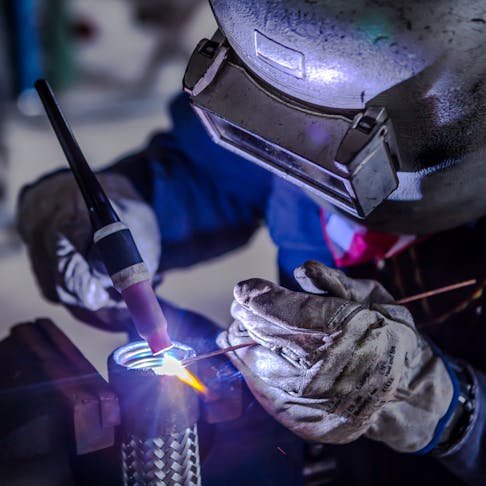The Ultimate Overview to Welding WPS Procedures: A Comprehensive Introduction for Welders
In the intricate world of welding, Welding Treatment Requirements (WPS) act as the backbone of making sure high quality, uniformity, and safety and security in welding operations. Comprehending the nuances of developing, executing, and monitoring WPS procedures is necessary for welders looking to raise their craft and satisfy market criteria. As we explore the different parts of a WPS and discover the complexities of qualification and qualification, we will certainly discover the essential function these procedures play in the realm of welding. Let's begin on a journey to decipher the complexities and importance of WPS procedures in welding practices.
Importance of WPS Procedures
Understanding the relevance of Welding Procedure Specs (WPS) procedures is important for ensuring the quality and integrity of bonded frameworks. WPS procedures act as a roadmap for welders, laying out the needed steps, specifications, and materials called for to accomplish a sound weld. By sticking to WPS guidelines, welders can make sure consistency in their job, causing structurally audio and reputable welds.
One of the key reasons that WPS procedures are important is their duty in preserving weld quality and stability. Following the specified welding criteria and strategies described in the WPS aids stop defects such as porosity, fracturing, or insufficient blend, which can compromise the stamina and resilience of the weld. In addition, WPS procedures are critical for guaranteeing conformity with industry requirements and codes. By adhering to established WPS guidelines, welders can demonstrate that their work meets the essential demands for safety and security and quality, providing guarantee to clients, inspectors, and governing bodies. Fundamentally, the relevance of WPS treatments can not be overemphasized, as they are essential to accomplishing consistent, high-grade welds that meet market criteria and specifications.

Parts of a WPS
A Welding Procedure Specification (WPS) typically comprises necessary elements that detail the details demands for performing a weld, making certain consistency and high quality in the welding process. The vital components of a WPS include necessary variables such as base metals, filler steels, interpass and preheat temperature levels, welding procedures, shielding gases, welding placements, and post-weld warmth treatment demands.
Base metals refer to the products being signed up with, while filler steels are made use of to load the space in between the base metals throughout welding. Preheat and interpass temperature levels are crucial for regulating the heat input and preventing issues like splitting or distortion. The welding process describes the details technique to be made use of, whether it's gas metal arc welding (GMAW), protected metal arc welding (SMAW), or an additional method. Securing gases secure the weld pool from atmospheric contamination. Welding settings define the alignments in which welding more can be executed. Post-weld heat therapy may be needed to relieve anxieties and improve the weld's properties. An extensive understanding of these parts is crucial for creating a extensive and efficient WPS.

Qualification and Accreditation
Having actually established the necessary parts of a Welding Treatment Specification (WPS), the emphasis currently changes towards the important elements of credentials and certification in welding techniques.

Accreditation, on the other hand, is the formal acknowledgment of a welder's credentials by an appropriate accreditation body or company. Welding qualifications are typically based upon the specific welding processes, products, and settings a welder is certified to collaborate with. Holding a valid welding qualification demonstrates that a welder satisfies market criteria and is qualified to carry out welding tasks to the required specs.
Producing a WPS
To create a Welding Procedure Specification (WPS) that satisfies industry criteria, cautious consideration of welding processes, materials, and functional criteria is vital. The first step in producing a WPS is to identify the welding procedure to be used, such as gas steel arc welding (GMAW) or shielded metal arc welding (SMAW)

Implementing and Keeping An Eye On WPS
Upon settling the comprehensive Welding Procedure Requirements (WPS) that carefully information welding procedures, materials, functional criteria, and quality control actions, the focus shifts to efficiently executing and checking the recognized treatments. Application involves making certain that all welders associated with the job are acquainted with the WPS and follow it meticulously throughout the welding procedure. This requires supplying adequate training and supervision to ensure adherence to the defined procedures. Keeping an eye on the WPS entails constant oversight to verify that welding activities line up with the recorded specifications. Evaluations, screening, and quality assurance measures are necessary elements of the tracking process to determine any problems or variances without delay. Normal audits and reviews of the welding procedures help in preserving consistency and quality throughout the project. Efficient application and surveillance of the WPS are critical for making certain the stability, stamina, and safety try this of the welded joints, ultimately contributing to the overall success of the welding project.
Conclusion
To conclude, understanding and following Welding Procedure Specs (WPS) is vital for welders to make certain high quality, consistency, and security in their work. By recognizing the parts of a WPS, acquiring correct certifications and accreditations, developing comprehensive treatments, and carrying out and monitoring them effectively, welders can enhance their skills and proficiency in welding techniques. Abiding by WPS procedures is you can try these out necessary for creating high-quality welds and conference market criteria.
In the intricate world of welding, Welding Treatment Specifications (WPS) offer as the backbone of guaranteeing quality, uniformity, and safety in welding operations. The welding procedure outlines the specific strategy to be used, whether it's gas steel arc welding (GMAW), secured steel arc welding (SMAW), or an additional method.To establish a Welding Procedure Spec (WPS) that fulfills industry criteria, cautious factor to consider of welding processes, products, and functional criteria is necessary. The first action in producing a WPS is to recognize the welding procedure to be used, such as gas steel arc welding (GMAW) or secured metal arc welding (SMAW)Upon completing the comprehensive Welding Procedure Requirements (WPS) that diligently details welding processes, materials, operational specifications, and quality assurance steps, the emphasis shifts to properly carrying out and checking the well established treatments.